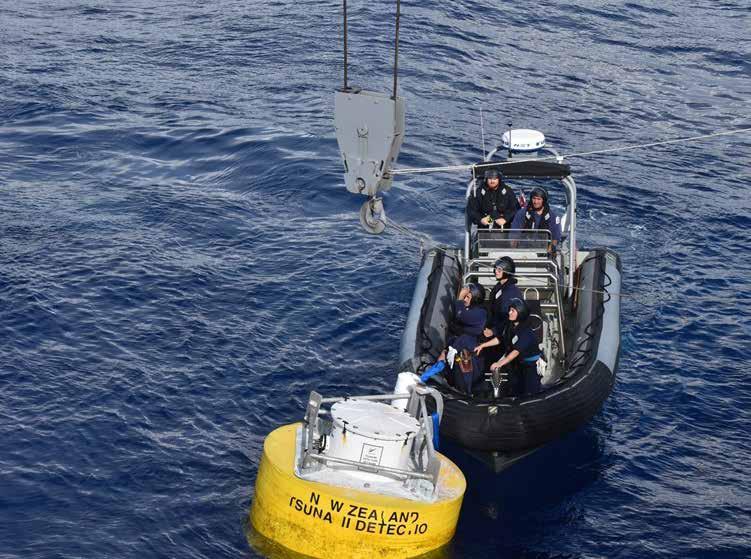
8 minute read
AOTEAROA hooks wave buoy
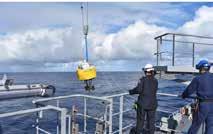
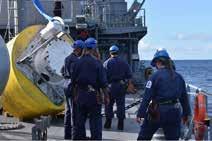
Advertisement
Navy retrieves drifting Pacific tsunami buoy
In favourable sea conditions, 250 nautical miles south east of Tonga, the crew of HMNZS AOTEAROA retrieved a Deep Ocean Assessment and Reporting of Tsunami (DART) buoy that had been drifting since it broke its mooring in December last year. The buoy was part of a network managed by the National Emergency Management Agency that provides tsunami monitoring and detection coverage for New Zealand and the south-west Pacific.
AOTEAROA was sailing back to New Zealand last month after three weeks of exercises with the Royal Australian Navy off the New South Wales coast, when she was tasked by the National Maritime Coordination Centre (NMCC) to locate and retrieve the 2.5m x 2m buoy weighing in at just over a tonne. It is thought a summer storm of significant intensity caused the buoy to break free from its mooring. The buoy was reporting its GPS co-ordinates every 24 hours and its position was being tracked while the recovery was planned. Once tasked, AOTEAROA altered course to intersect the last reported position of the buoy. On Wednesday this week, AOTEAROA located it and her Commanding officer, Captain Simon Rooke, carefully positioned the ship so its crane was over the buoy that had been secured by a crew in a Rigid Hull Inflatable Boat (RHIB). Matching the movement of the ship and buoy, the RHIB crew timed the movement correctly to attach the buoy to the hook of the crane and it was lifted aboard.
The successful recovery took four hours from location of the buoy to its secure storage on the flight deck of the ship. It was brought back to New Zealand once the ship had undergone its mandatory 14-day quarantine period at sea. “As the Navy’s new maritime sustainment vessel, HMNZS AOTEAROA was designed to undertake a wide range of tasks,” said Maritime Component Commander Commodore Mat Williams. “These include refuelling ships and helicopters, transporting equipment and supplies, assisting government agency partners in their scientific and research work as well as helping in Humanitarian Aid and Disaster Relief efforts. Now we can add retrieval of tsunami buoys to that ever-growing list.” Paul Smith, Director of the National Maritime Coordination Centre, applauded the successful retrieval as an excellent example of the diverse range of support that the New Zealand Defence Force provides to civilian agencies across a broad spectrum of maritime activities. “The NZDF and NMCC work very closely together with other agencies to support the effective and efficient use of maritime assets for the benefit of New Zealand,” he said. “Very, very welcome news,” was how Roger Ball, Acting Director Civil Defence Emergency Management, described hearing about the buoy retrieval. “We are very grateful for the assistance of the Navy and the professionalism of officers and crew in HMNZS AOTEAROA in diverting the 2,200 nautical miles to retrieve the buoy and bring it home,” he said. “These buoys are located in one of the harshest oceans in the world so we always factor in that there will be some percentage of downtime. This is why our network has multiple deployed DART buoys to ensure the system is never compromised and continues to operate and provide the highly useful data we require when we experience the very rare sort of issue we’ve just had.”
TE MANA: from building site to Navy ship
In Frigate Systems Upgrade terms, HMNZS TE MANA could be said to be on the homeward stretch. Navy Today Editor Andrew Bonallack catches up with the team in Canada as TE MANA is returned to the Navy.
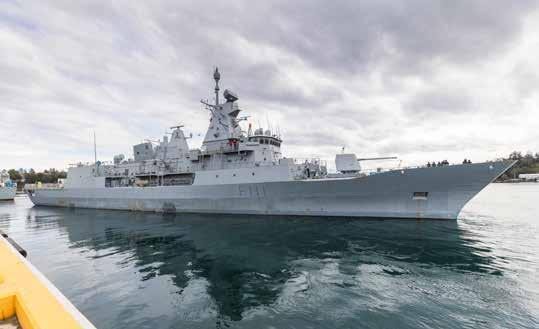
She might not be a new ship, but HMNZS TE MANA has to be treated like one for her Harbour Assurance Readiness Check (HARC) and her centre of gravity. TE MANA, which arrived in Esquimalt, Canada on 12 March 2019, is following in the footsteps of her sister ship HMNZS TE KAHA in undertaking her Frigate Systems Upgrade by Lockheed Martin Canada. Her new fore and aft masts, radars, electronic detection equipment, self-defence missile system, decoys and sonar upgrades are now substantially complete. Last month the contractors signed over the ship to the custody of Commanding Officer, Commander Mike Peebles, and the ship moved across Esquimalt Harbour to the Fleet Maintenance Facility. In doing so TE MANA transitions from a building site to a warship – with a lot of work ahead before she heads to sea.
The HARC assessment is a milestone in the generation of a ‘new’ ship and time has to be given to the Ship’s Company to get familiar with the vessel again and develop their Standard Operating Procedures. Over the course of a week, and under the direction of the Navy’s Maritime Operational Evaluation Team (MOET), the crew demonstrate their ability to conduct Damage Control and Casualty Removal Handling. MOET then test them with simulated galley fire, fuel spill and toxic gas exercises. Upcoming work at Fleet Maintenance will include work on her propulsion systems and generators, numerous tank inspections, touch-ups, recertification of all magazines prior to embarking her armament and incline experiments. With the latter, the ship is tested to determine its stability, lightship weight and coordinates of its centre of gravity. It is done on new ships greater than 24 metres in length, or on ships that have had alterations with the potential to affect the centre of balance.
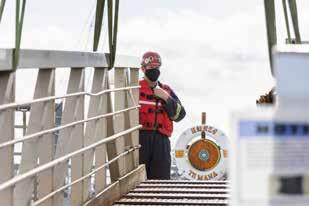
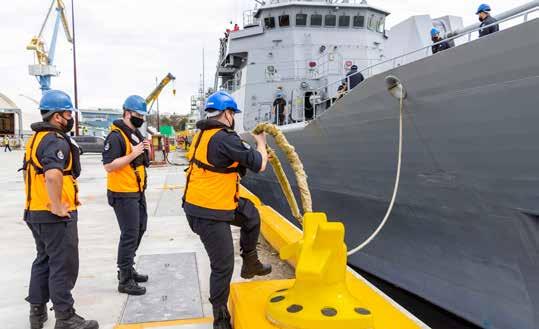
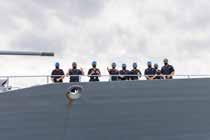
At time of writing the Ship’s Company could not move back on board, due to lack of ‘hotel’ services – working galley and running water. Once Fleet Maintenance have ticked that off, the crew will work towards the ship’s Sea Assurance Readiness Checks, with TE MANA going to sea for trials later in the year. TE MANA’s Executive Officer, Lieutenant Commander Paddy Baker, has served in TE MANA for the majority of his naval career. “I’m really looking forward to getting some more miles under the keel,” he says. “Frigates are an essential part of the RNZN fleet in that they are a key training platform for the full spectrum of naval operations, and most of all” I am looking forward to training a new Ship’s Company in how a combatant operates, as well as learning the capability that the new systems will allow us to bring.” COVID-19 restrictions in Canada were a huge culture shock to the New Zealanders, he says. “Mask wearing and physical distancing are just everyday requirements now. Canada continues to see the impact of additional COVID 'waves'. This has resulted in restrictions tightening at times in an attempt to limit the community spread.” He says it’s when you are deployed that you really get a sense of a Ship’s Company’s character and fortitude. “We’re certainly seeing both in spades. For some of our personnel, they have been in Canada for years, for the majority it has been three months. We have had to develop new ways of safely conducting our roles on board ship, and had to work within the restrictions to find our own fun when and where we can. On a daily basis, I can also see young leaders standing up and bringing TE MANA back to life, in a lot of cases when they are learning about the ship and systems for the very first time. “I am immensely proud of TE MANA and her Ship’s Company, as well as my role within it. I can’t wait to shortly welcome the remainder of our Ship’s Company, and to progress our collective capability to restore TE MANA as the foremost fighting frigate.
~ Lieutenant Commander
Paddy Baker
Partners in Canada
OET Sean Keven
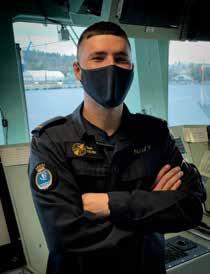
With the regeneration of HMNZS TE MANA taking up much of 2021, sailors had the option of having their partners with them in Canada.
Ordinary Electrical Technician Sean Keven and his partner arrived in Canada on 8 January and are housed in a two-bedroom furnished apartment in Esquimalt, where TE MANA is berthed.
As a junior rating, OET Keven says he feels very fortunate and supported in being able to have his partner with him. The Defence Force covered her travel expenses and have given the pair subsidised housing. OET Keven also receives Non-Operational Posting Allowances (NOPA) which helps cover their costs. “To allow her to accompany me, we had to get our relationship recognised beforehand, which requires writing a Minute and getting permission from the ship’s Commanding Officer. With the help of my supervisors we got this completed on time, and then it was a case of getting visas and travel documents sorted.”
The crew had to isolate for two weeks in their quarters before they could work. “The rules here feel similar to New Zealand’s level 2.5. Masks are required indoors and on public transport, and gatherings are limited to 10 people. We work from 0745 to 1545 Monday to Friday, our daily routine is quite varied, between working on our task books, and doing section work like setting up computers, or fixing equipment.” Even with COVID restrictions, there’s plenty of room to move in Canada. “Since isolation, my partner and I have made a snowman, climbed Bear Mountain and checked out an old castle. We’ve got plans to hit the slopes. When I first joined the RNZN two years ago, I had only heard rumours of posting to Canada. But now I’m here, living and working. This is a great opportunity, not only to experience another country, but to learn from my superiors and push my career forward.”



